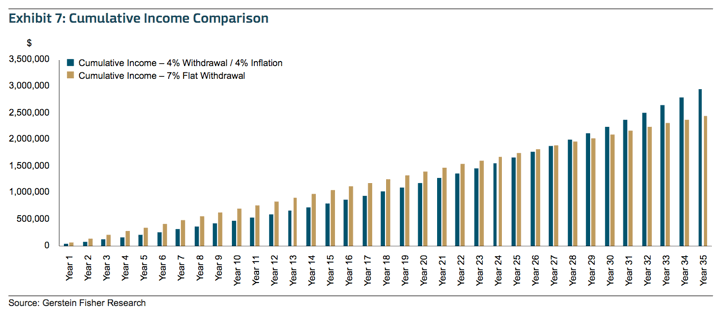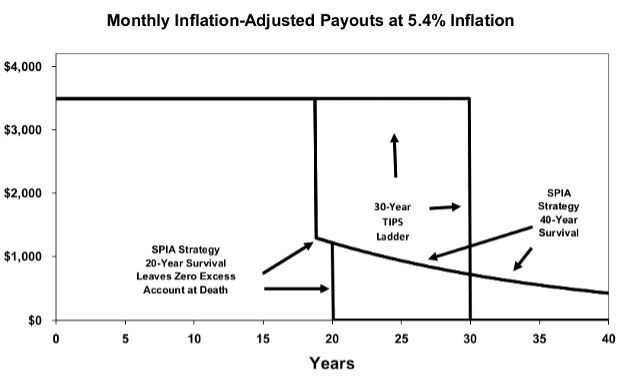This is inadvertently turning into a multi-part series, mostly revolving about taking advantage of long-term TIPS to build guaranteed inflation-adjusted income. Are the current real TIPS yields worthy of locking in? The previous parts:
- 4% Guaranteed Withdrawal Rate (Inflation-Adjusted) with TIPS Ladder
- Historical Inflation Chart: 10-Year Rolling Average 1872-2022
- Sustainable Portfolio Withdrawal Rates During High-Inflation Periods
Following up on the Gerstein article from that last post, a final chart that was interesting compared the cumulative income from a low start that adjusts with inflation and a higher start that stays fixed. Starting with a $1 million portfolio, consider two simple theoretical scenarios. First, a 4% initial withdrawal rate ($40,000 in Year 1) that adjusts upward to keep up with 4% steady annual inflation. Second, a fixed annuity-style payment of $70,000 a year. Here’s how that plays out:

In such a scenario, their chart shows that the total cumulative income paid out would even out around year 27.
I was happy to see that William Bernstein – highly respected in index investing circles but relatively spare with words these days – wrote a new article Playing Inflation Russian Roulette in Retirement with a lot of good nuggets. He compares the retirement income from a single-premium immediate annuity and a 30-year TIPS ladder.
The comparison gets a bit complicated (see article to fully explain chart below), but I did take away the idea that even if you start with $70,000 annuity income like in the above scenario, you only spend $40,000 and put excess ($30,000 in year 1) rest aside in a “for future inflation” side account. You can still increase your $40,000 a year of spending annually, but keep putting the difference into the excess side account. This excess amount will decrease over time until the inflation-adjusted spending reaches and surpasses $70,000 a year, at which time you start withdrawing from the excess side account. In addition, we should consider the money left over in case of early death.

In the end, Bernstein seems to lean towards the TIPS ladder as he points out the danger of high inflation. He reminds us that “worst-case historically” doesn’t actually mean “worst-case”. How many times recently have we read the words “biggest [something] ever”?
One is reminded of Nassim Taleb’s dictum that “this so-called worst-case event, when it happened, exceeded the worst case at the time.” In other words, 5.4% long-term inflation is nowhere near the worst-case scenario. Even a casual glance at the global history of fiat money in the twentieth century shows that hyperinflation is the rule, not the exception. During the above-mentioned 1966-1995 period, U.S. debt/GDP averaged around 50%; now, it’s more twice that level and rising rapidly, and given the hundreds of trillions of dollars of additional implicit debt (promises to Social Security and Medicare, and to backstop future emergencies – think military aid to Ukraine and weather or terrorism disaster relief) it won’t take much to tip things over into a debt spiral, especially if the Treasury has to roll its debt over at higher interest rates for very long.
He also reminds us that we don’t have to do either one – the easiest way for most of us to access additional inflation-adjusted income is to delay taking Social Security:
It would be nice if one could purchase inflation-adjusted annuities, but those products have gone the way of disco, and I suspect that proposing their revival would not be a career enhancing move for any insurance company executive who suggests it. The best that one can do in this regard is to “purchase” the inflation-adjusted annuity offered by spending down one’s retirement assets to defer Social Security until age 70.
Finally, I wanted to include his relatively-conservative views on safe withdrawal rates:
The single most important factor that determines how to do that is the nest-egg burn rate (your annual spending divided by the size of your retirement portfolio). I suggest the following rule of thumb: if your burn rate is below 2% at age 60, below 3% at age 70, or below 4% at age 80, a standard stock/bond portfolio will nicely see you through your retirement, and you have no need to annuitize your assets.
I plan to keep an eye on real TIPS yields, and may readjust within the bond portion of my portfolio to purchase individual TIPS at longer maturities.
 The Best Credit Card Bonus Offers – 2025
The Best Credit Card Bonus Offers – 2025 Big List of Free Stocks from Brokerage Apps
Big List of Free Stocks from Brokerage Apps Best Interest Rates on Cash - 2025
Best Interest Rates on Cash - 2025 Free Credit Scores x 3 + Free Credit Monitoring
Free Credit Scores x 3 + Free Credit Monitoring Best No Fee 0% APR Balance Transfer Offers
Best No Fee 0% APR Balance Transfer Offers Little-Known Cellular Data Plans That Can Save Big Money
Little-Known Cellular Data Plans That Can Save Big Money How To Haggle Your Cable or Direct TV Bill
How To Haggle Your Cable or Direct TV Bill Big List of Free Consumer Data Reports (Credit, Rent, Work)
Big List of Free Consumer Data Reports (Credit, Rent, Work)
“the easiest way for most of us to access additional inflation-adjusted income is to delay taking Social Security”
Thats a good point there. I plan to do that myself. If you can use your 401k or cash to support yourself until you’re 70 years old you can max your social security which has built in inflation.
However people are concerned rightfully that SS might fail or is ‘bankrupt’. I think thats what keeps lots of people from ignoring SS, many have just written it off as not dependable long term since they think its a given that in some future decade the government will revise SS and screw us all.